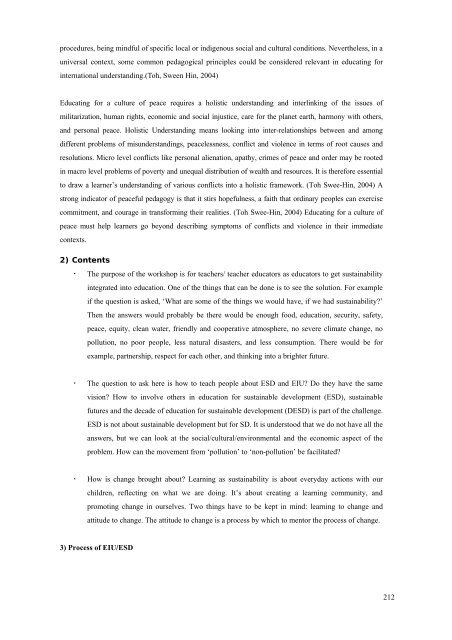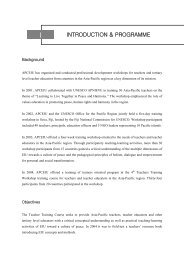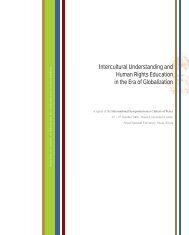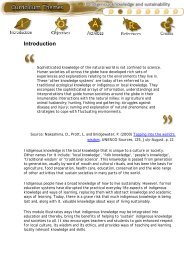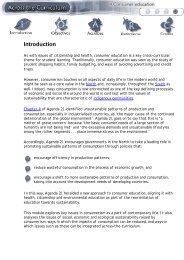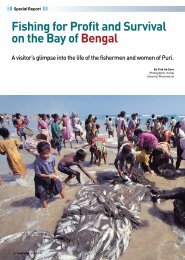REPORT OF UNESCO EXPERT MEETING ON - APCEIU
REPORT OF UNESCO EXPERT MEETING ON - APCEIU
REPORT OF UNESCO EXPERT MEETING ON - APCEIU
Create successful ePaper yourself
Turn your PDF publications into a flip-book with our unique Google optimized e-Paper software.
procedures, being mindful of specific local or indigenous social and cultural conditions. Nevertheless, in a<br />
universal context, some common pedagogical principles could be considered relevant in educating for<br />
international understanding.(Toh, Sween Hin, 2004)<br />
Educating for a culture of peace requires a holistic understanding and interlinking of the issues of<br />
militarization, human rights, economic and social injustice, care for the planet earth, harmony with others,<br />
and personal peace. Holistic Understanding means looking into inter-relationships between and among<br />
different problems of misunderstandings, peacelessness, conflict and violence in terms of root causes and<br />
resolutions. Micro level conflicts like personal alienation, apathy, crimes of peace and order may be rooted<br />
in macro level problems of poverty and unequal distribution of wealth and resources. It is therefore essential<br />
to draw a learner’s understanding of various conflicts into a holistic framework. (Toh Swee-Hin, 2004) A<br />
strong indicator of peaceful pedagogy is that it stirs hopefulness, a faith that ordinary peoples can exercise<br />
commitment, and courage in transforming their realities. (Toh Swee-Hin, 2004) Educating for a culture of<br />
peace must help learners go beyond describing symptoms of conflicts and violence in their immediate<br />
contexts.<br />
2) Contents<br />
• The purpose of the workshop is for teachers/ teacher educators as educators to get sustainability<br />
integrated into education. One of the things that can be done is to see the solution. For example<br />
if the question is asked, ‘What are some of the things we would have, if we had sustainability?’<br />
Then the answers would probably be there would be enough food, education, security, safety,<br />
peace, equity, clean water, friendly and cooperative atmosphere, no severe climate change, no<br />
pollution, no poor people, less natural disasters, and less consumption. There would be for<br />
example, partnership, respect for each other, and thinking into a brighter future.<br />
• The question to ask here is how to teach people about ESD and EIU? Do they have the same<br />
vision? How to involve others in education for sustainable development (ESD), sustainable<br />
futures and the decade of education for sustainable development (DESD) is part of the challenge.<br />
ESD is not about sustainable development but for SD. It is understood that we do not have all the<br />
answers, but we can look at the social/cultural/environmental and the economic aspect of the<br />
problem. How can the movement from ‘pollution’ to ‘non-pollution’ be facilitated?<br />
• How is change brought about? Learning as sustainability is about everyday actions with our<br />
children, reflecting on what we are doing. It’s about creating a learning community, and<br />
promoting change in ourselves. Two things have to be kept in mind: learning to change and<br />
attitude to change. The attitude to change is a process by which to mentor the process of change.<br />
3) Process of EIU/ESD<br />
212


